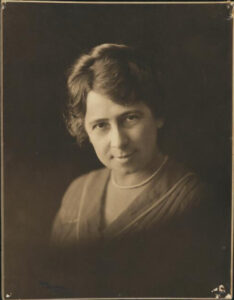by Amy E Mack (1876-1939)
On Wednesday, we introduced Amy Mack, a writer of fiction and non-fiction that dealt almost exclusively with nature. Today’s story is one of her newspaper columns. It features her description of the nature of a suburban street and the plants, particularly trees, found along it. It conveys her knowledge of her subject, and her love of Australian nature in particular.
Its name is more suitable than names generally are, for though on one side it faces a cleared, grassy reserve, and looks away to the river, on the other it is bordered by garden after garden, each with its different wealth of beauty. Black painted fences succeed grey stone walls; white palings join red brick, and over and above all grow hedges of hawthorn, private, and laurel, with here and there an intruding tries to lend sweetness and colour.
Jealously the hedges hide the beauties be hind them, but the unfettered scents of lilies, mignonette, and roses float over the road, and I picture grass lawns with stiff standard roses, rows of tall white lilies, quaint box borders, surrounding beds of long foxgloves. Canterbury bells, and purple pansies, for they must be old-fashioned, those gardens behind the tall straight hedges.
But though the flowers are sheltered from sight, there are treasures within the gardens that the hedges cannot conceal, and these are the trees. Oaks and elms, willows and limes, ashes and sycamores, they lean far out above the sentinels of hawthorn and privet, and throw their friendly shade across the avenue. The eye revels in their beauty, and their very names are a joy, each one with its memory of old time song or story. Bonny Prince Charlie seems to peep from the blank branches of the wide-spreading oak; the sycamore growing next recalls sad Desdemona and her song; a group of sweet-scented limes or lindens, are haunted with memories of Heine; “hard by a poplar shook away, all silver green with gnarled bark”, and from beyond comes:
The moan of doves in memorial elms
And murmur of innumerable bees.
Each tree has its charm of romance and poetry, and the soul should be soothed and satisfied; yet a vague unrest stirs within me, and a feeling of incompleteness, which I cannot understand. Then I turn a bend in the avenue, and know what was missing.
There, before me, rearing its splendid head above all others, stands a red gum; covered in blossom, it is a mine of sweetness for the hundreds of honeyeaters feeding amongst its branches. In this Garden Avenue, stocked with trees and flowers from far off climes, the gum tree and the honeyeaters stand out in bold relief, fresh and strong and free. The tall white trunk rises above the tallest oak, and its branches stretch proudly skywards, as though to leave beneath it the thought that here in its own land it is a stranger amongst strangers. To an Australian heart it fills a want that no traces of old romance can satisfy. It does not bond its branches across the road as if to gossip to each passer by, but lifts its head regally towards heaven, and speaks not of a bygone history, not of old song and story, but of a golden future to be. It tells of battles bravely fought, of courageous hearts that have carved their way through drought and flood, that have fought hand to hand with nature herself, and conquered. It is an emblem of the nation to be, strong, fearless, and erect, living no more in the past glories of the motherland, but carving its own history on the uncut rocks of the future.
And I pass on my way, glad with the knowledge that beyond the narrow sweetness of the Garden Avenue there are millions of tall gum trees speaking the same golden message to all who will hear.
_________
Amy Mack, “Along the Garden Avenue“, published in The Sydney Morning Herald, 23 February 1907 (Retrieved June 28, 2023)





